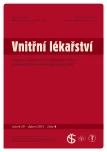Case history acquired haemophilia A
Authors:
Z. Čermáková 1; R. Hrdličková 2; Š. Blahutová 2; A. Ligová 3
Authors‘ workplace:
Lékařská fakulta OU Ostrava, děkan doc. MU Dr. Jaroslav Horáček, CSc.
1; Krevní centrum FN Ostrava, přednostka prim. MU Dr. Zuzana Čermáková, Ph. D.
2; Ústav klinické hematologie Lékařské fakulty OU a FN Ostrava, přednosta prim. MU Dr. Jaromír Gumulec
3
Published in:
Vnitř Lék 2013; 59(4): 313-316
Category:
Case Reports
Overview
Acquired haemophilia A is a rare form of acquired coagulopathy caused by autoantibodies against coagulation factor VIII. It is characterized by major bleeding complications often life – threatening. An estimated incidence is about 1 – 2 cases per million inhabitants per year. The authors report case history of acquired haemophilia in 85 year old woman. Bleeding complications were well controled by bypassing agents. Inhibitor eradication was successful after the use of second line agent rituximab.
Key words:
acquired haemophilia A – factor VIII inhibitor – rituximab
Sources
1. Hay CR, Brown S, Collins PW et al. The diagnosis and management of factor VIII and IX inhibitors: a guidline from the United Kingdom Haemophilia Centre Doctors’ Organization. Br J Haematol 2006; 133 : 591 – 605.
2. Huth-Kuhne A, Baudo F, Collins P et al. International recommendations on the diagnosis and treatment of patients with acquired hemophilia A. Haematologica 2009; 94 : 566 – 575.
3. Sborov DW, Rodgers GM. Acquired hemophilia A: a curent review of autoantibody disease. Clin Adv Hematol Oncol 2012; 10 : 19 – 27.
4. Holme PA, Brosstad F, Tjønnfjord GE. Acquired haemophilia: management of bleeds and immune therapy to eradicate autoantibodies. Haemophilia 2005; 11 : 510 – 515.
5. Collins P, Baudo F, Huth - Kuhne A et al. Consensus recommendations for the diagnosis and treatment of acquired hemophilia A. BMC Research Notes 2010; 3 : 161.
6. Smejkal P, Buliková A, Chlupová G et al. Získaná hemofilie A. Vnitř Lék 2012; 58 : 571 – 578.
7. Collins PW, Hirsch S, Baglin TP et al. Acquired hemophilia A in the United Kingdom: 2‑year national surveillance study by the United Kingdom Haemophilia Centre Doctors’ Organization. Blood 2007; 109 : 1870 – 1877.
8. Buliková A, Smejkal P, Zavřelová J et al. Získané inhibitory krevního srážení. Interní Med 2008; 10 : 336 – 339.
Labels
Diabetology Endocrinology Internal medicine Surgery Intensive Care Medicine Cardiology Clinical oncology Trauma surgery LaboratoryArticle was published in
Internal Medicine

2013 Issue 4
- Metamizole vs. Tramadol in Postoperative Analgesia
- Metamizole at a Glance and in Practice – Effective Non-Opioid Analgesic for All Ages
- Metamizole in perioperative treatment in children under 14 years – results of a questionnaire survey from practice
- Possibilities of Using Metamizole in the Treatment of Acute Primary Headaches
- Spasmolytic Effect of Metamizole
Most read in this issue
- Aortic stenosis
- Lung metastases as the first manifestations of occult medullary microcarcinoma
- The „Short Physical Performance Battery“ in the Czech Republic – the pilot and validation study in older persons
- Perindopril in the treatment of hypertension and cardiovascular diseases: evolution continues with the orodispersible dosage form
